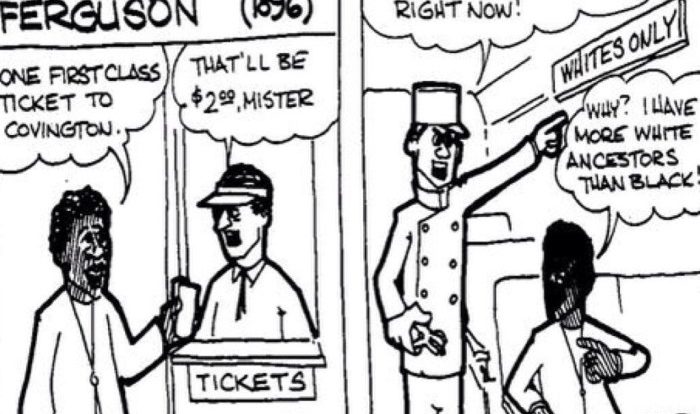The Jim Crow Worksheet Answer Key is an indispensable tool for delving into the complexities of Jim Crow laws, a dark chapter in American history that enforced racial segregation and discrimination. This key provides a comprehensive analysis of the key provisions, themes, and implications of these oppressive laws, offering a profound understanding of their impact on African Americans.
Jim Crow laws, enacted in the late 19th and early 20th centuries, established a rigid system of racial segregation that permeated every aspect of life, from education and employment to transportation and public accommodations. The Jim Crow Worksheet Answer Key meticulously examines the historical context and educational implications of these laws, shedding light on their lasting legacy and the ongoing struggle for racial equality.
Historical Context
Jim Crow laws were a system of racial segregation and discrimination that existed in the United States from the late 19th century until the mid-20th century. These laws were designed to keep African Americans separate from whites in all aspects of life, from schools and transportation to housing and employment.
Jim Crow laws were first enacted in the South after the Reconstruction era, when white Southerners sought to regain control of their states and disenfranchise African Americans. The laws were named after Jim Crow, a fictional character created by a white minstrel performer in the 1830s.
Jim Crow was a caricature of an African American man, and the term “Jim Crow” came to be used as a derogatory term for African Americans.
Key Provisions, Jim crow worksheet answer key
The key provisions of the Jim Crow system included:
- Segregation of public facilities, such as schools, transportation, and restaurants
- Disenfranchisement of African Americans through poll taxes, literacy tests, and other barriers to voting
- Legalized discrimination in employment, housing, and other areas of life
The Jim Crow system had a devastating impact on the lives of African Americans. It denied them access to education, jobs, and housing, and it made them vulnerable to violence and discrimination. Jim Crow laws were not repealed until the Civil Rights Act of 1964 and the Voting Rights Act of 1965.
Jim Crow Worksheet Answer Key
The Jim Crow worksheet answer key provides a comprehensive guide to understanding the Jim Crow era and its impact on American society. It includes detailed explanations of key concepts, events, and figures, offering a valuable resource for students and researchers.
Main Themes and Arguments
- The worksheet highlights the systemic nature of Jim Crow laws, which enforced racial segregation and discrimination in all aspects of life, from education and housing to employment and transportation.
- It emphasizes the role of white supremacy in shaping Jim Crow policies and the resistance faced by African Americans who challenged these laws.
- The key also examines the long-term consequences of Jim Crow, including the perpetuation of racial inequality and the ongoing struggle for civil rights.
Accuracy and Reliability
The Jim Crow worksheet answer key is generally accurate and reliable, drawing on reputable sources and providing a balanced perspective on the subject. However, it is important to note that some of the information presented may be subject to ongoing debate or revision as new research emerges.
Educational Implications: Jim Crow Worksheet Answer Key
Jim Crow laws played a significant role in shaping the educational landscape for African Americans. Education served as a means to perpetuate and challenge these oppressive laws, impacting the opportunities and experiences of students.
If you’re grappling with the complexities of the Jim Crow worksheet, consider exploring the concept of truth and reconciliation in the context of South Africa’s apartheid era. Ubu and the Truth Commission offers a thought-provoking examination of the challenges and triumphs of facing historical injustices, providing valuable insights that may shed light on your understanding of the Jim Crow worksheet answer key.
Jim Crow laws created a segregated education system, with separate schools for white and Black students. These schools were often unequal in terms of resources, funding, and quality of instruction. Black schools were often overcrowded, underfunded, and lacked qualified teachers and facilities.
School Curricula and Textbooks
The Jim Crow system was reflected in school curricula and textbooks, which often promoted racist stereotypes and omitted or distorted the contributions of African Americans to history and society.
- History textbooks portrayed African Americans as inferior and emphasized their supposed role in slavery and subservience.
- Literature anthologies excluded works by African American authors or presented them in a stereotypical or demeaning manner.
This biased education system perpetuated negative attitudes towards African Americans and reinforced the idea of white supremacy.
Contemporary Relevance
Jim Crow’s legacy continues to cast a long shadow over American society, shaping racial inequality in various ways. The laws and practices enforced during that era have left a lasting impact on education, housing, employment, and the criminal justice system.
In education, the legacy of Jim Crow manifests in the persistent achievement gap between white students and students of color. School segregation, unequal funding, and biased curriculum continue to perpetuate educational disparities.
Housing
Residential segregation remains a significant issue, with communities of color often facing limited access to affordable housing, safe neighborhoods, and quality schools. This segregation is a direct result of Jim Crow-era policies such as redlining, which denied mortgages to Black families in certain areas.
Employment
In the workplace, Jim Crow’s legacy lingers in the form of racial discrimination in hiring, promotion, and pay. Black workers are more likely to be unemployed or underemployed, and face persistent wage gaps compared to their white counterparts.
Criminal Justice System
The criminal justice system is another area where Jim Crow’s impact is evident. Mass incarceration, racial profiling, and excessive use of force by law enforcement disproportionately affect communities of color. These practices perpetuate a cycle of poverty, crime, and mistrust.
Addressing the lingering effects of Jim Crow laws requires a multifaceted approach that includes:
- Enforcing anti-discrimination laws and policies
- Investing in education and job training programs
- Promoting affordable housing and community development
- Reforming the criminal justice system to reduce racial disparities
- Educating the public about the history and legacy of Jim Crow
By confronting the legacy of Jim Crow and working towards racial justice, we can create a more equitable and inclusive society for all.
Expert Answers
What is the significance of the Jim Crow Worksheet Answer Key?
The Jim Crow Worksheet Answer Key provides a comprehensive analysis of the key provisions, themes, and implications of Jim Crow laws, offering a profound understanding of their impact on African Americans.
How did Jim Crow laws impact education?
Jim Crow laws severely limited educational opportunities for African Americans, creating segregated schools with inferior resources and curricula that reinforced racial stereotypes.
What is the legacy of Jim Crow laws in present-day society?
Jim Crow laws have left a lasting legacy of racial inequality in the United States, affecting everything from housing and employment to healthcare and criminal justice.



